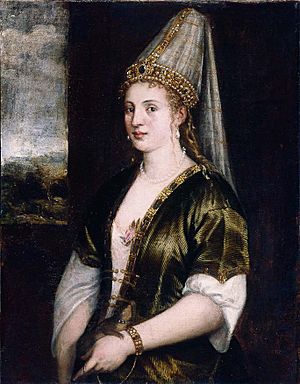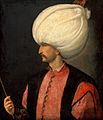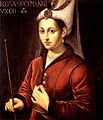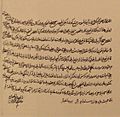Hurrem Sultan facts for kids
Quick facts for kids Hurrem Sultan |
|||||
|---|---|---|---|---|---|

Portrait by Titian titled La Sultana Rossa, c. 1550
|
|||||
| Haseki Sultan of the Ottoman Empire (Imperial Consort) |
|||||
| Tenure | 1533/1534 – 15 April 1558 | ||||
| Successor | Nurbanu Sultan | ||||
| Born | Alexandra or Anastasia 1502–1506 Ruthenia, Kingdom of Poland (now Ukraine) |
||||
| Died | 15 April 1558 (aged 51–56) Topkapı Palace, Istanbul, Ottoman Empire (now Turkey) |
||||
| Burial | Süleymaniye Mosque, Istanbul | ||||
| Spouse | Suleiman the Magnificent | ||||
| Issue |
|
||||
|
|||||
| Father | ? Lisovsky | ||||
| Religion | Sunni Islam, previously Eastern Orthodox Christian | ||||
Hurrem Sultan (born around 1502 – died April 15, 1558), also known as Roxelana, was a very important woman in the Ottoman Empire. She was the main wife of Suleiman the Magnificent, one of the most powerful Ottoman sultans. Hurrem became one of the most influential women in Ottoman history. She was also a key figure during a time called the Sultanate of Women, when royal women had a lot of power.
Hurrem was born in a region called Ruthenia, which is now part of Ukraine. Back then, it was part of the Kingdom of Poland. She was captured during a raid and eventually brought to Istanbul, the capital city of the Ottoman Empire. She entered the royal palace, where she quickly became the favorite of Sultan Suleiman. Breaking old traditions, Suleiman married Hurrem, making her his legal wife. Before this, sultans usually only married foreign noblewomen. She was the first royal wife to receive the special title of Haseki Sultan. Hurrem stayed in the sultan's court for the rest of her life. She had six children with Suleiman, including Selim II, who would later become a sultan himself. She was also the grandmother of Murad III.
Contents
Hurrem Sultan's Rise to Power
Hurrem Sultan gained a lot of power and had a big impact on the politics of the Ottoman Empire. Through her husband, she played an active role in important government matters. She often advised the sultan and even wrote important letters to other rulers, like King Sigismund II Augustus of Poland.
Building Important Places
Hurrem also supported many large building projects. These included the Haseki Sultan Complex, which had a mosque, a hospital, and a school. She also helped build the Hagia Sophia Hurrem Sultan Bathhouse, a famous public bath. These projects showed her influence and her care for the people.
Family Life and Legacy
Hurrem Sultan lived in the royal palace and had a close relationship with Sultan Suleiman. Their marriage was unusual for its time, showing how much Suleiman valued her. She was a loving mother to her children, especially to Selim II, who became sultan after his father. Hurrem died in 1558 in Istanbul. She was buried in a special tomb within the Süleymaniye Mosque complex, a grand mosque built by her husband. Her story is remembered as one of great influence and change in the Ottoman Empire.
Images for kids
-
Statue of Roxolana (Nastia Lisovska) in Rohatyn, Ukraine
-
16th century Latin oil painting of Hurrem Sultan titled Rosa Solymanni Vxor (Rosa, Süleyman's Wife)
-
Letter of Hurrem Sultan to Sigismund II Augustus, congratulating him on his accession to the Polish throne in 1549.
-
Haseki Sultan Complex designed by the architect Mimar Sinan.
-
The türbe (mausoleum) of Hurrem Sultan at Süleymaniye Mosque in Fatih, Istanbul.
-
The son of Hurrem Sultan and Suleiman the Magnificent, Selim II
-
A painting of Hurrem Sultan by a follower of Titian, 16th century
-
Roxelana and Süleyman the Magnificent by the German baroque painter Anton Hickel, (1780)
See also
 In Spanish: Roxelana para niños
In Spanish: Roxelana para niños


















